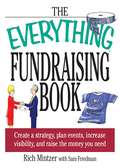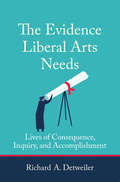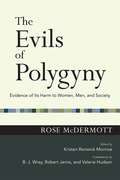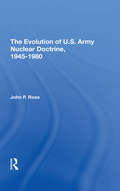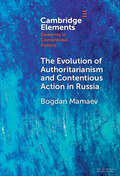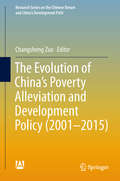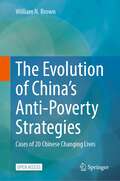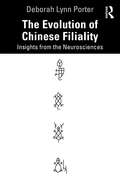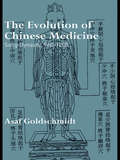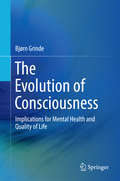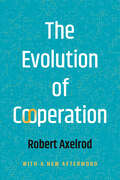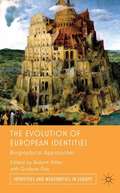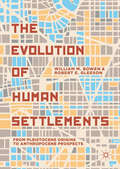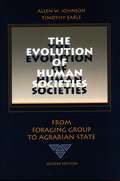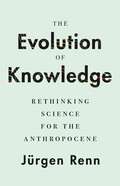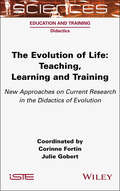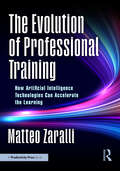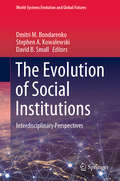- Table View
- List View
The Everything Freemasons Book: Unlock the Secrets of This Ancient And Mysterious Society! (Everything® Series)
by Barb Karg John K YoungFor thousands of years, one clandestine organization has been rumored to control the destinies of men, cities, even nations: Freemasonry. Often traced back to the stonemason guilds of the Middle Ages, Freemasons were supposedly to be found among all the great minds of the Renaissance, including Da Vinci. The Freemasons have claimed such illustrious personages as Mozart, Benjamin Franklin, Darwin, FDR, Churchill, W.C. Fields, Herbert Hoover, and many others as members. Even today, Freemasonry boasts Masonic lodges all over the globe. The Everything Freemasons Book examines all the aspects of this fascinating organization, including: -myths, legends, and stories of this ancient order—what&’s true and what&’s not -the closely guarded secret rituals, symbols, and esoteric arts -the Freemasons&’ enemies—from the Catholic Church to the Nazis -the many controversies surrounding this secret society—past and present
The Everything Fundraising Book: Create a Strategy, Plan Events, Increase Visibility, and Raise the Money You Need (Everything® Series)
by Richard Mintzer Sam FriedmanThe Everything Fundraising Book makes fundraising easy with step-by-step instruction and advice from the experts. Whether you are a community volunteer or a professional fundraiser, this clear and practical guide shows you exactly how to set goals, create a plan, and tap into a financial goldmine of corporate and government endowments.Features timely information on how to:budget your fundraiser and cover expensesattract and work with volunteerschoose and organize campaigns and eventsuse corporate fundraisers to increase visibilitypitch to reluctant donors and sponsorsand more!Experienced fundraisers Rich Mintzer and Sam Friedman walk you through the process and help you avoid the pitfalls, so you can focus all your energy on reaching your fundraising goals.
The Everything Guide to Customer Engagement: Connect with Customers to Build Trust, Foster Loyalty, and Grow a Successful Business
by Linda PophalExpert advice and strategies for winning--and keeping--customers!Apple, L.L. Bean, Zappos.com, Nordstrom, Lego, Southwest Airlines. All of these extraordinarily successful businesses have one thing in common: They have famously loyal customers. These companies understand that customer engagement is just as important as quality products and services when it comes to customer loyalty and retention. With The Everything Guide to Customer Engagement, you can learn the highly successful strategies that have been working for business all over the world. Inside, you'll find essential information on how you can better:Reach customers in person and onlineCreate a communityBuild your social media presenceBring in new businessGrow your reputation It doesn't matter if your business is large, medium, or small. With this guide, you'll learn the tips and techniques to make your customers and their priorities your number one focus, now and in the future.
The Everything Store: Jeff Bezos and the Age of Amazon
by Brad StoneThe definitive story of Amazon.com, one of the most successful companies in the world, and of its driven, brilliant founder, Jeff Bezos.Amazon.com started off delivering books through the mail. But its visionary founder, Jeff Bezos, wasn't content with being a bookseller. He wanted Amazon to become the everything store, offering limitless selection and seductive convenience at disruptively low prices. To do so, he developed a corporate culture of relentless ambition and secrecy that's never been cracked. Until now. Brad Stone enjoyed unprecedented access to current and former Amazon employees and Bezos family members, giving readers the first in-depth, fly-on-the-wall account of life at Amazon. Compared to tech's other elite innovators--Jobs, Gates, Zuckerberg--Bezos is a private man. But he stands out for his restless pursuit of new markets, leading Amazon into risky new ventures like the Kindle and cloud computing, and transforming retail in the same way Henry Ford revolutionized manufacturing.THE EVERYTHING STORE will be the revealing, definitive biography of the company that placed one of the first and largest bets on the Internet and forever changed the way we shop and read.
The Evidence Liberal Arts Needs: Lives of Consequence, Inquiry, and Accomplishment
by Richard A. DetweilerEmpirical evidence for the value of a liberal arts education: how and why it has a lasting impact on success, leadership, altruism, learning, and fulfillment.In ongoing debates over the value of a college education, the role of the liberal arts in higher education has been blamed by some for making college expensive, impractical, and even worthless. Defenders argue that liberal arts education makes society innovative, creative, and civic-minded. But these qualities are hard to quantify, and many critics of higher education call for courses of study to be strictly job-specific. In this groundbreaking book, Richard Detweiler, drawing on interviews with more than 1,000 college graduates aged 25 to 65, offers empirical evidence for the value of a liberal arts education. Detweiler finds that a liberal arts education has a lasting impact on success, leadership, altruism, learning, and fulfillment over a lifetime. Unlike other defenders of a liberal arts education, Detweiler doesn&’t rely on philosophical arguments or anecdotes but on data. He developed a series of interview questions related to the content attributes of liberal arts (for example, course assignments and majors), the context attributes (out-of-class interaction with faculty and students, teaching methods, campus life), and the purpose attributes (adult life outcomes). Interview responses show that although both the content of study and the educational context are associated with significant life outcomes, the content of study has less relationship to positive adult life outcomes than the educational context. The implications of this research, Detweiler points out, range from the advantages of broadening areas of study to factors that could influence students&’ decisions to attend certain colleges.
The Evils of Polygyny: Evidence of Its Harm to Women, Men, and Society (The Easton Lectures)
by Rose McDermottWhy do men act violently toward women?What are the consequences of "normal violence," not only for women and children but also for the men who instigate it, and for the societies that sanction it?The Evils of Polygyny examines one powerful structural factor that instigates, enforces, and replicates patterns of male dominance: the practice of polygyny. From more than a decade’s worth of study, Rose McDermott has produced a book that uncovers the violent impact of polygyny on women, children, and the nation-state and adds fundamentally to the burgeoning focus on gender concerns in political psychology and international relations. Integrating these fields, as well as domestic policy and human rights, the author urges us to address the question of violence toward women and children. If we do not, a system that tells young women they must marry whom their elders dictate and devote their entire lives to serving others will continue to plague the contemporary world, and restrict development.The timely nature of McDermott’s book reflects the mission of the Easton Lectures at the Interdisciplinary Center for the Scientific Study of Ethics and Morality at the University of California, Irvine, which charges its lecturers to produce work that is creative, controversial, and cutting-edge, and offers substantial real-world impact. The Evils of Polygyny, edited by Kristen Renwick Monroe, includes commentary from Valerie Hudson, Robert Jervis, and B. J. Wray. The book does just that, providing a coherent analysis of sexual violence and a provocative and chilling analysis of one of the major problems of the contemporary world.
The Evolution Of U.s. Army Nuclear Doctrine, 1945-1980
by John P RoseThe development of U.S. Army nuclear doctrine—policies, plans, procedures, tactics, and techniques—since World War II, its impact on Army forces, and its role in future wars is the subject of this policy-oriented analysis. The definition of Army nuclear doctrine advanced by the author clearly implies a distinction between policy for the employment of nuclear weapons as determined by the president and the role adduced by the Army. Dr. Rose suggests that developments—both nuclear and conventional—in U.S. Army tactical doctrine have been more responsive to political preferences held by national authorities than to the real nature of the potential threat and rigors of the nuclear battlefield. Further, he argues that the type of war preparations favored by U.S. political authorities over the last fifteen years and the type of war for which the Soviet Union is preparing differ markedly, making the U.S. Army poorly prepared for a major war.
The Evolution of Authoritarianism and Contentious Action in Russia (Elements in Contentious Politics)
by Bogdan MamaevThis Element examines the evolution of authoritarianism in Russia from 2011 to 2023, focusing on its impact on contentious action. It argues that the primary determinant of contention, at both federal and regional levels, is authoritarian innovation characterized by reactive and proactive repression. Drawing on Russian legislation, reports from human rights organizations, media coverage, and a novel dataset of contentious events created from user-generated reports on Twitter using computational techniques, this Element contributes to the understanding of contentious politics in authoritarian regimes, underscoring the role of authoritarianism and its innovative responses in shaping contentious action.
The Evolution of China's Poverty Alleviation and Development Policy (Research Series on the Chinese Dream and China’s Development Path)
by Changsheng ZuoThis book explains in simple language the change of perspective and the transition of the systems for poverty alleviation, based on the fifteen-year development of China’s poverty alleviation policy. Written by scholars from the International Poverty Reduction Center in China, Peking University and the China Agricultural University who have been engaged in the field of poverty alleviation for many years, the contributions combine views on China's poverty reduction policy with the authors’ personal experiences. It is a valuable reference resource for researchers at the forefront of poverty alleviation and also appeals to anyone interested in poverty alleviation and China’s poverty alleviation changes.
The Evolution of China’s Anti-Poverty Strategies: Cases of 20 Chinese Changing Lives
by William N. BrownThis open access book presents the findings of the author’s 3 decades of studying China’s evolving anti-poverty strategies. It argues that much of the billions that nations spend yearly on economic aid is used inefficiently or to treat the symptoms but not the root causes of poverty. China, however, has evolved an effective sustainable alternative by providing the means for self-reliance to not only relieve economic poverty but also poverty of spirit. As a result, the success of China’s historic war on poverty has been due not only to top-down visionary leadership but also to the bottom-up initiatives of an empowered populace unswervingly united in ending poverty.From 1993 to 2019, the author drove over 200,000 km around China and interviewed hundreds of people from all walks of life as he explored the evolution of China’s anti-poverty strategies from simplistic aid and redistribution, which often engendered dependency and poverty of spirit. Over time, the philosophy shifted to empowerment by fostering self-reliance—or as Chinese put it, “blood production rather than blood transfusion.” The primary method of empowerment was to provide modern infrastructure, “Roads first, then riches,” so rural dwellers in remote Inner Mongolia or the Himalayan heights of Tibet had the same access to markets, jobs and internet for e-commerce as their urban counterparts. People who seized the opportunities and prospered first then used their newfound wealth and experience to help others.The stories in this book include a Tibetan entrepreneur whose family was impoverished in spite of 300 years of service to the Panchen Lama, or the farm girl with 4 years of education who now has several international schools, a biotechnology company and poverty alleviation projects across China, or the photographer who walked 40,000 km through deserts to chronicle the threat of desertification. Their tales underscore how diverse people across China helped make possible China’s success in alleviating absolute poverty and why Chinese are now confident in achieving a “moderately prosperous society.”
The Evolution of Chinese Filiality: Insights from the Neurosciences
by Deborah Lynn PorterThis unique book brings a fresh interdisciplinary approach to the analysis of ancient Chinese history, creating a historical model for the emergence of cultural mainstays by applying recent dramatic findings in the fields of neuroscience and cultural evolution. The centrality in Chinese culture of a deep reverence for the lives of preceding generations, filial piety, is conventionally attributed to Confucius (551-479 B.C.), who viewed hierarchical family relations as foundational for social order. Here, Porter argues that Confucian conceptions of filiality themselves evolved from a systemized set of behaviors and thoughts, a mental structure, which descended from a specific Neolithic mindset, and that this psychological structure was contoured by particular emotional conditions experienced by China’s earliest farmers. Using case study analysis from Neolithic sky observers to the dynastic cultures of the Shang and Western Zhou, the book shows how filial piety evolved as a structure of feeling, a legacy of a cultural predisposition toward particular moods and emotions that were inherited from the ancestral past. Porter also brings new urgency to the topic of ecological grief, linking the distress central to the evolution of the filial structure to its catalyst in an environmental crisis. With a blended multidisciplinary approach combining social neuroscience, cultural evolution, cognitive archaeology, and historical analysis, this book is ideal for students and researchers in neuropsychology, religion, and Chinese culture and history.
The Evolution of Chinese Medicine: Song Dynasty, 960–1200 (Needham Research Institute Series)
by Asaf GoldschmidtThe history of Chinese medicine hinges on three major turning points: the formation of canonical theory in the Han dynasty; the transformation of medicine via the integration of earlier medical theories and practices in the Song dynasty; and the impact of Western medicine from the nineteenth century onwards. This book offers a comprehensive overview of the crucial second stage in the evolution of Chinese medicine by examining the changes in Chinese medicine during the pivotal era of the Song dynasty. Scholars often characterize the Song era as a time of change in every aspect of political, social, intellectual or economic life. More specifically it focuses on three narratives of change: the emperor's interest in medicine elevated the status of medicine in the eyes of the elite, leading to an increased involvement of intellectuals and the literary elite in medicine government officials systematically revised, printed, and promulgated earlier heterogeneous medical manuscripts belonging to various traditions the government established unique imperially sponsored medical institutions to handle public health and other aspects of medicine. As the first book to study the transformation medicine underwent during the Song period this volume will appeal to Sinologists and scholars of the history of medicine alike.
The Evolution of Consciousness
by Bjørn GrindeThis book gives the reader an understanding of what consciousness is about, and of how to make conscious experiences more pleasant. It expands on a new theory that describes the evolutionary trajectory leading to conscious life forms. In short, the evidence suggests that consciousness first evolved some 300 million years ago as a consequence of the introduction of feelings. Feelings offer a strategy for making behavioural decisions. Besides playing a crucial role in the evolution of the human mind, they are a key factor in regard to mental health and quality of life. Fortunately, the human brain is plastic. By exploiting available options for modulating the mind, it is therefore possible to impact on what sort of experiences the brain serves. More specifically, you can strengthen the capacity for positive feelings and reduce the sway of negative feelings. The text covers biological, neurological, psychological, and philosophical aspects of the mind.
The Evolution of Cooperation
by Robert Axelrod&“For anyone involved in settling disputes&” (Richard Dawkins), a famed political scientist offers a classic argument for how to achieve a more cooperative world We assume that, in a world ruled by natural selection, selfishness pays. So why cooperate? In The Evolution of Cooperation, political scientist Robert Axelrod seeks to answer this question. In 1979, he organized the famed Computer Prisoner&’s Dilemma Tournament, which sought to find the most effective strategy for the ubiquitous prisoner&’s dilemma, a model of strategy problems in the nuclear age. The expectation had been that some complicated scheme of competition would win the day. Instead, a simple, cooperative program called Tit for Tat did. The effects of that victory continue to reverberate today, from college campuses to the Situation Room. A vital book for leaders and decision-makers, The Evolution of Cooperation reveals how cooperative principles help us think better about everything from military strategy to political elections to family dynamics.
The Evolution of Educational Thought: Lectures on the formation and development of secondary education in France (The\yale Cultural Sociology Ser.)
by Emile DurkheimFirst Published in 2005. Routledge is an imprint of Taylor & Francis, an informa company.
The Evolution of European Identities
by Robert Miller Graham DayThe 'European project' is in a state of perpetual crisis in which the root cause is a lack of identification by ordinary citizens with Europe and European institutions. The Evolution of European Identities employs state of the art analysis of in-depth interviews by renowned practitioners to give a unique 'bottoms up' perspective on the development (or its lack) of a sense of 'European mental space'. Linking conceptual findings with case studies, the book provides unique insights into groups that have been especially sensitized by their life experiences to question what it means to be European in the twenty-first century. The groups explored in this book include: adults who experienced European education exchanges when young; transnational workers; civil society organization activists; persons involved in cross-border intimate relationships; farmers who are subject to European markets, regulations and subsidies; and migrants into 'fortress Europe'.
The Evolution of Household Technology and Consumer Behavior, 1800-2000 (Modern Heterodox Economics)
by Julia Sophie WoersdorferThe increasing division and specialization of labor between the market and the nonmarket sector is a central stylized fact of long-run economic development. Over time, a large share of activities which had formerly been carried out by the private household itself has become replaced by market alternatives, raising at the same time the demand for consumer goods. <P><P> The neoclassical economic framework of household production theory relates the increasing demand for household technology to rising wages and opportunity costs of time: the higher the wage rate, the more costly it is to spend time in unpaid housework activities. Consumer products are thus purchased to make household production processes more efficient and to substitute capital goods for the household’s time (time substitution hypothesis). Although this hypothesis sounds plausible at first sight, it cannot capture the essential phenomena underlying the complex process of the mechanization of the home over the past 200 years. Its major weakness lies in the treatment of consumer preferences, whose explanatory potential is explicitly factored out. <P><P> Using the washing of clothes as a microcosm of household economics, this book examines long-term changes in cleanliness consumption patterns from the perspective of an evolutionary economic, psychologically informed consumer theory. Woersdorfer shows how the historical evolution of cleanliness consumption over the past 200 years is the result of the interplay of supply and demand side factors, namely, technical change in washing technology on one side and motivational driving forces and consumer learning capabilities on the other. Hence, not changing relative prices but innate consumer needs and consumer learning processes, leading to a growing understanding of how to satisfy those needs, are the essential driving forces behind the rising technological endowment of the home and the corresponding demand for household appliances. <P><P> The Evolution of Household Technology and Consumer Behavior, 1800–2000 will be of interest to researchers in the field of evolutionary economics, history of technology, economic history, innovation economics and sociology.
The Evolution of Household Technology and Consumer Behavior, 1800-2000 (Modern Heterodox Economics)
by Julia Sophie WoersdorferThe increasing division and specialization of labor between the market and the nonmarket sector is a central stylized fact of long-run economic development. Over time, a large share of activities which had formerly been carried out by the private household itself has become replaced by market alternatives, raising at the same time the demand for consumer goods.The neoclassical economic framework of household production theory relates the increasing demand for household technology to rising wages and opportunity costs of time: the higher the wage rate, the more costly it is to spend time in unpaid housework activities. Consumer products are thus purchased to make household production processes more efficient and to substitute capital goods for the household’s time (time substitution hypothesis). Although this hypothesis sounds plausible at first sight, it cannot capture the essential phenomena underlying the complex process of the mechanization of the home over the past 200 years. Its major weakness lies in the treatment of consumer preferences, whose explanatory potential is explicitly factored out.Using the washing of clothes as a microcosm of household economics, this book examines long-term changes in cleanliness consumption patterns from the perspective of an evolutionary economic, psychologically informed consumer theory. Woersdorfer shows how the historical evolution of cleanliness consumption over the past 200 years is the result of the interplay of supply and demand side factors, namely, technical change in washing technology on one side and motivational driving forces and consumer learning capabilities on the other. Hence, not changing relative prices but innate consumer needs and consumer learning processes, leading to a growing understanding of how to satisfy those needs, are the essential driving forces behind the rising technological endowment of the home and the corresponding demand for household appliances.The Evolution of Household Technology and Consumer Behavior, 1800–2000 will be of interest to researchers in the field of evolutionary economics, history of technology, economic history, innovation economics and sociology.
The Evolution of Human Settlements: From Pleistocene Origins To Anthropocene Prospects
by William M. Bowen Robert E. GleesonThis book analyzes the history and development of settlements—from the earliest periods in human history to the present day—from a Darwinian evolutionary perspective. At the foundation of the evolutionary model is the argument that the human capacity for complex communication and unique problem-solving ability have led to the formation and reality of the modern city and its scaled-up megacity status. While evolutionary theory forms the platform for the book’s argument, general systems theory provides the operational framework for the organization and interpretations of each chapter. Throughout the book, the authors tackle various issues, questions, and possibilities regarding the future development and evolution of human settlements.
The Evolution of Human Sociability
by Ron VannelliHow do desires and fears motivate human sociability? What effect do these motivators have on reproductive, social and political behaviour? And, crucially, how might we understand them separate from preconceived notions of design or higher morality? Taking these questions as a focus, this book examines human evolution with the emphasis on sexual selection and the evolution of a number of human psychological processes. Exploring evolutionary, sexual and maturational processes, along with primate, fossil and geological evidence, Vannelli argues that human nature can be conceptualised as species-typical desires and fears, derived from sexual selection during human evolution, and that these are major motivators of behaviour. Presenting additional evidence from the anthropology of band societies, along with material from group behaviour, Vannelli highlights the importance of pair-bonding, friendship, alliance behaviour, vengeance seeking and interpersonal politics in social behaviour, providing a unique interdisciplinary framework for understanding human nature and the evolution of human sociability.
The Evolution of Human Societies: From Foraging Group to Agrarian State
by Allen W. Johnson Timothy K. EarleBy combining an original thesis and a representative body of ethnographic data, this ambitious work seeks to describe and explain the growth in complexity of human societies. <P><P> Its emphasis is on the causes, mechanisms, and patterns of cultural evolution, which the authors explain in terms of a coherent theory of political economy defined as the mobilization and exchange of goods and services between families. The authors show that the interconnected processes of technological change and population growth are the motor of social change, resulting in three related processes intensification, integration, and stratification that transform human societies over time. The validity of their theory rests on evidence drawn from 19 case studies that range widely over time and space. <P><P> For this new edition, the authors have thoroughly rewritten the theoretical argument for greater clarity, updated the case materials to incorporate new research, and added a new chapter that applies their theoretical perspective to the problems of change since the industrial revolution and the globalization of trade and political influence.
The Evolution of Knowledge: Rethinking Science for the Anthropocene
by Jürgen RennA fundamentally new approach to the history of science and technologyThis book presents a new way of thinking about the history of science and technology, one that offers a grand narrative of human history in which knowledge serves as a critical factor of cultural evolution. Jürgen Renn examines the role of knowledge in global transformations going back to the dawn of civilization while providing vital perspectives on the complex challenges confronting us today in the Anthropocene—this new geological epoch shaped by humankind.Renn reframes the history of science and technology within a much broader history of knowledge, analyzing key episodes such as the evolution of writing, the emergence of science in the ancient world, the Scientific Revolution of early modernity, the globalization of knowledge, industrialization, and the profound transformations wrought by modern science. He investigates the evolution of knowledge using an array of disciplines and methods, from cognitive science and experimental psychology to earth science and evolutionary biology. The result is an entirely new framework for understanding structural changes in systems of knowledge—and a bold new approach to the history and philosophy of science.Written by one of today's preeminent historians of science, The Evolution of Knowledge features discussions of historiographical themes, a glossary of key terms, and practical insights on global issues ranging from climate change to digital capitalism. This incisive book also serves as an invaluable introduction to the history of knowledge.
The Evolution of Life: Teaching, Learning and Training - New Approaches on Current Research in the Didactics of Evolution
by Corinne Fortin Julie GobertThe aim of this collective work is to give an account of the topicality and dynamics of new research in the didactics of evolution, by articulating francophone and international work. The various contributions pursue a reflection on the challenges of teaching and learning about evolution, based on historical, epistemological and societal approaches. The themes addressed illustrate the vitality and diversity of research issues in educational sciences, from primary school to university. Structured around different theoretical fields (problematization, didactics of the curriculum, nature of science, etc.), this book explores the content, teaching and learning processes and approaches, teaching practices, as well as pre-service and in-service teacher training, with a view to both intelligibility and feasibility.
The Evolution of Professional Training: How Artificial Intelligence Technologies Can Accelerate the Learning
by Matteo ZaralliStructured into three distinct parts, this book is an indispensable resource for navigating the evolution of education and professional training in the age of artificial intelligence (AI) and virtual reality.The book’s Introduction speaks to the current context, a period marked by crisis and a digital industrial revolution, emphasizing how the advent of cutting-edge technologies such as artificial intelligence is fundamentally altering work and social dynamics. It then examines AI, exploring its distinctive features compared to human intelligence and introducing the concept of spatial computing. It illustrates how these technological advancements are expanding the possibilities for human-machine interaction.In the first part, the focus shifts to artificial intelligence, the importance of data in training intelligent systems, and the emerging concept of the augmented worker. This section explores how AI can enhance human capabilities, facilitate more efficient and personalized learning or training, and promote unprecedented professional development.The second part ventures into philosophical reflections and ethical considerations regarding the future of work and AI’s impact on daily reality. It discusses the changing work paradigm, the challenges posed by increasing digitalization, how AI contributes to an altered perception of truth, and the implications of the multiple digital identities that people can assume in virtual spaces. A task and reflection that businessmen, executives, and managers need to consider.Finally, the third part emphasizes the critical importance of training, examining how virtual reality and artificial intelligence technologies can accelerate the learning and mastery of hard and soft skills. This section delves into the different sectors that have been or will be transformed by these technologies’ integration, offering perspectives on how best to prepare for the challenges and opportunities of the future.This book is not just an analysis of the impact of emerging technologies on learning and professional development; it is also an invitation to reflect on the future of work, the nature of intelligence, and the evolution of human society in the digital age. Balancing technical insights with philosophical considerations, it targets a broad audience, from educators to professionals, policymakers to the curious, providing tools to understand and navigate the rapid transformations of our time.
The Evolution of Social Institutions: Interdisciplinary Perspectives (World-Systems Evolution and Global Futures)
by David B. Small Dmitri M. Bondarenko Stephen A. KowalewskiThis book presents a novel and innovative approach to the study of social evolution using case studies from the Old and the New World, from prehistory to the present. This approach is based on examining social evolution through the evolution of social institutions. Evolution is defined as the process of structural change. Within this framework the society, or culture, is seen as a system composed of a vast number of social institutions that are constantly interacting and changing. As a result, the structure of society as a whole is also evolving and changing. The authors posit that the combination of evolving social institutions explains the non-linear character of social evolution and that every society develops along its own pathway and pace. Within this framework, society should be seen as the result of the compound effect of the interactions of social institutions specific to it. Further, the transformation of social institutions and relations between them is taking place not only within individual societies but also globally, as institutions may be trans-societal, and even institutions that operate in one society can arise as a reaction to trans-societal trends and demands. The book argues that it may be more productive to look at institutions even within a given society as being parts of trans-societal systems of institutions since, despite their interconnectedness, societies still have boundaries, which their members usually know and respect. Accordingly, the book is a must-read for researchers and scholars in various disciplines who are interested in a better understanding of the origins, history, successes and failures of social institutions.

